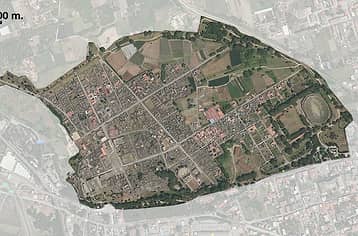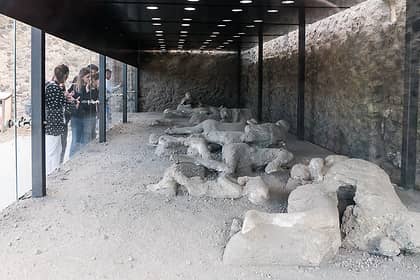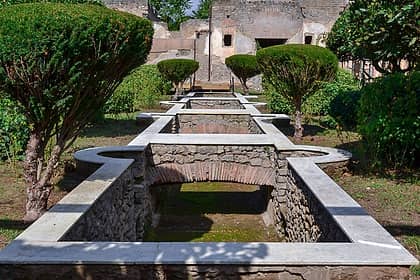- Home
- Visiting the Ruins of Pompeii
Visiting the Ruins of Pompeii

The archaeological ruins of Pompeii cover around 440,000 square meters, a vast area that would take at least three full days to explore completely. Pompeii is an entire buried city with public squares, temples, baths, buildings, private villas, and shops. A visit to the city's forum alone takes about an hour.
That said, you can easily take a shorter itinerary that includes some of the archaeological site’s most famous areas, giving you an idea of what daily life was like in this Roman city.
Here we suggest a few sites that you should include during your visit to the ruins of Pompeii. The sites are marked with the same names as the free map provided at the ticket office and info point at the entrance to the archaeological park.
Pompeii is one of the most significant archaeological treasures not only in Campania, but in all of Italy. Its history fascinates scholars and visitors from all over the world, who come to admire the city that became frozen in time with the eruption of Mount Vesuvius. Pompeii is the most unique example in Italy of urban preservation from antiquity, where the streets, houses, temples and even graffiti have endured through the centuries, offering us an invaluable glimpse into the daily life of a Roman city.
A brief history of Pompeii
A brief history of Pompeii
Pompeii was probably founded by the Oscans around the 8th century BC. This ancient Italic people settled on the southern slopes of Mount Vesuvius along the banks of the Sarno River, which was navigable at the time. Pompeii became an important commercial center early on, catching the interest of the invading Greeks and Etruscans. The Etruscans were conquered on the waters off Cuma, and the city came under domination by the Samnites in the 5th century BC.
As a Samnite city, Pompeii entered into the Nucerine League and the tufo stone city walls were both expanded and fortified, allowing the city itself to grow. Pompeii became known as an important exporter of olive oil and wine, benefiting from the Mediterranean free market under Roman protection.
After the end of the Samnite Wars in 80 BC, the city came under Roman dominance and in 89 BC Publius Cornelius Silla took up residency there along with a group of veterans, renaming the city Colonia Venerea Pompeianorum Sillana.
During its Roman period, the city reached its architectural and economic peak, transforming into one of the most popular recreational and resort towns of the Roman aristocracy. During the Imperial Age, many wealthy Roman families moved to Pompeii, and buildings like the Temple of Fortuna Augusta and the Building of Eumachia are testimony to this influx.
Under the Emperor Nero, the city was seriously damaged due to a strong earthquake in 62 AD, and rebuilding immediately began. Work was interrupted on 24 August of 79 AD by the disastrous eruption of Mount Vesuvius, which buried the city under volcanic ash.
Visiting the crater on Mount Vesuvius
A cloud, from which mountain was uncertain, at this distance (but it was found afterwards to come from Mount Vesuvius), was ascending, the appearance of which I cannot give you a more exact description of than by likening it to that of a pine tree, for it shot up to a great height in the form of a very tall trunk, which spread itself out at the top into a sort of branches; occasioned, I imagine, either by a sudden gust of air that impelled it, the force of which decreased as it advanced upwards, or the cloud itself being pressed back again by its own weight, expanded in the manner I have mentioned; it appeared sometimes bright and sometimes dark and spotted, according as it was either more or less impregnated with earth and cinders."
(Pliny the Younger)
Excavation of Pompeii began in 1748 under King of Naples Charles III of Bourbon, who was interested in the project's prestige for the royal house and did not undertake the dig with particular scientific or systematic vigor. Excavation work increased during the French occupation at the beginning of the 19th century, though was halted almost completely with the return of the Bourbon kings. During this period came the discovery of the House of the Faun, with its excellent mosaic depicting the Battle of Alexander at Issus. The discovery created such a stir that archaeological work began again at the site, this time using scientific methodology, careful record keeping, and plaster casting. From 1924 to 1961, work was overseen by the Italian archaeologist Amedeo Maiuri and included important discoveries.
In recent years, excavations of new areas in the site have been halted and work is concentrated on restoring and maintaining buildings that have already been unearthed.
Pompeii archaeological park is recognized as a UNESCO World Heritage Site. When you visit, perhaps with a guided tour, a private tour, or a small group tour, you’ll experience a wealth of history showing daily life in the ancient city of Pompeii. A walking tour with an expert guide is a wonderful way to explore Pompeii. You can also organize a visit at your own pace, with a brief visit of just two hours all the way to a full day tour. Below are some suggestions for sites we recommend for a walking tour of Pompeii.
2 Hour, 4 Hour, and 7 Hour Itineraries
2 Hour, 4 Hour, and 7 Hour Itineraries
Sites to visit from the Porta Marina Inferiore Piazza Esedra entrance (the second entrance from the Circumvesuviana “Pompei Villa Dei Misteri” stop along the Sorrento - Naples line)
Quadriporticus of the theatres or Gladiators Barracks (VIII - 11)
Large Theatre (VIII - 10) *
Small Theatre - Odeon (VIII - 12)
House of the Menande ( I - 7)
House of Casca Longus (I - 2)
Fullery of Stephanus (I - 3)
House of the Lararium of Achilles (I - 4)
Garden of the Fugitives (I - 16) *
Necropolis of Nocera Gate (II - 10)
Amphitheater (II - 5) *
Praedia of Giulia Felice (II - 3) *
House of Venus in the shell (II - 2)
House of Octavius Quartio (II - 1)
House of the Epidii (IX - 5)
Stabian Baths (VII - 16)
Lupanar (VII - 18) *
House of the Faun (VI - 1) *
House of the Vettii (VI - 11)
House of the Golden Cupids (VI - 12)
House of the Ara Maxima (VI - 13)
From Torre XI up to Herculaneum Gate (VI - 16)
Villa of the Mysteries (VI - 19) *
Forum Baths (VII - 10)
Forum (VII - 6a) *
Temple of Jupiter (VII - 8)
Forum Granary (VII - 7)
Basilica (VIII - 2) *
Sanctuary of Venus (VIII - 1) *
Porta Marina Superiore exit
Legend
* Top 10
Area + number on the official map in parenthesis
Visiting Pompeii with kids
Visiting Pompeii with kids
It isn't easy to get around Pompeii with a stroller or pushchair, as the ancient Roman roads that cross the city are not navigable on wheels. Wheelchair users can follow a special marked route with the free map provided at the entrance, and the same itinerary can be followed with a stroller. Regardless, the best way to visit with infants and young children is by using a carrier or backpack. There are a number of Baby Points inside the archaeological park, which are small bungalows marked on the map. You can request keys at the park entrance and use these spaces to change and feed your infant in complete privacy.
Where to eat
Where to eat
If you've decided to dedicate a full day to Pompeii, the best option for lunch is packing a picnic to eat inside the park. You'll find a number of picnic areas marked on the park map available that's available at the entrance. Large bags are not allowed inside, so you'll have to pack your food and beverages in small bags or backpacks. Purchase your supplies in Naples or Sorrento, as the snack bars inside the park are expensive.
In Sorrento, the Salumeria Aprea (located on Via Tasso in the historic center and at the beginning of Via del Mare) makes excellent Caprese sandwiches and often has “casatiello,” a soft savory bread baked with diced ham, traditionally made at Easter. In Naples, pick up a sandwich at a cafè or take-away near the Stazione Centrale, or stop in Eccellenze della Costiera to choose some traditional sweet treats from the Amalfi Coast.
For a sit-down meal:
Hortus (tel: +39 081 536 4566) Located along the road between the train station and the Porta Marina entrance, this spot is popular among tourists and offers a number of take-away options for a light lunch, or local dishes served in the pleasantly cool citrus garden.
Caupona (tel: +39 081 1855 7911) If you want to continue your historical experience, walk five minutes from Villa dei Misteri to this restaurant opposite Piazza Esedra. It serves ancient recipes created by the Roman gourmet Marcus Gavius Apicius, served on terracotta plates by waiters dressed in period garb against the background of ancient music and frescoed walls inspired by Pompeii.
Guided tours
Guided tours
If you prefer to explore Pompeii accompanied by an expert, a guided tour is the ideal option.
Authorized guides are easily recognizable by their official badges and can be found at the main entrance to Pompeii, Porta Marina. You can also find tour guides at the Piazza Esedra entrance.
For an even more convenient experience, you can book a guided tour online in advance. By choosing a tour guide, you'll hear fascinating stories and in-depth details about daily life in this ancient Roman city, from the Forum to the magnificent aristocratic villas.
Top ten Pompeii sites
1. Large Theater and Odeon (VIII - 10)
1. Large Theater and Odeon (VIII - 10)

Pompeii's two theaters are located in the same area of the ancient city. The Teatro Grande (Large Theater) is an open-air amphitheater where Greek-Roman plays were performed; the smaller Odeon was used for poetry and musical performances, which required a smaller covered space for the best acoustics. Tip: stand in the middle of the Odeon's stage and speak in a normal voice. You'll hear your own voice amplified, as if you have spoken into a microphone.
2. Garden of the Fugitives (I – 16)
2. Garden of the Fugitives (I – 16)

The Orto dei Fuggiaschi (Garden of the Fugitives) was an old quarter of the city that was converted to vineyards as Pompeii grew. The name pays tribute to the bodies of 13 victims of the eruption in 79 AD who were trying to escape through Porta Nocera before succumbing to the ashes and stone. Their remains were discovered using plaster casting during excavations in 1961-62 and 1973-74.
3. Amphitheater (II – 5)
3. Amphitheater (II – 5)

Built around 70 BC, Pompeii's ancient amphitheater is one of the best preserved in the world. Used for sporting events and gladiator battles, the space could seat 20,000 spectators in three sections. The first rows were for prominent citizens, the middle rows were for the middle class, and the summa, or the highest rows, were for the rest of the population.
4. Praedia of Giulia Felice (II – 3)
4. Praedia of Giulia Felice (II – 3)

The Praedia di Giulia Felice is a large complex dating from the 1st century BC and was one of the first homes unearthed during excavations. This aristocratic villa has a large gardens surrounding a series of residential buildings and thermal baths. The name Giulia Felice was taken from an inscription painted on the facade after the earthquake of 62 AD (today displayed in Naples' National Archaeological Museum) in which the owner advertises that part of the property is for rent. The lavish decorations in the residential and thermal areas are particularly beautiful.
5. Lupanar (VII - 18)
5. Lupanar (VII - 18)

The lupanare (lupanar) was the city's brothel, and is one of the most memorable sites within the ruins of Pompeii. It was a two-story complex, with five small cells on the ground floor and five upstairs. Each cell had a stone bed topped with a mat or cushion, and above the door of each cell was an erotic fresco that probably depicted the specialization of the prostitute that worked in each individual cell. Though the brothel is located between two side streets, it was (and still is) easy to find by following the phallic symbols on the flagstones and facades of nearby buildings.
6. House of the Faun (VI – 1)
6. House of the Faun (VI – 1)

The Casa del Fauno (House of the Faun) is one of the largest and most spectacular houses in Pompeii, covering around 3,000 square meters with areas dedicated to the villa's owners and other areas for the servants. The name comes from a bronze satyr statue in the impluvium (a small pool for gathering rain water), and the villa has a number of statues, frescoes, and mosaics. Among the most famous is the mosaic that depicts Alexander the Great battling Darius and the Persians at Issus, now displayed at the National Archaeological Museum in Naples.
7. Villa of the Mysteries (VI – 19)
7. Villa of the Mysteries (VI – 19)

Discovered between 1909 and 1910, the Villa dei Misteri (Villa of the Mysteries) is one of the most captivating and mysterious in the entire archaeological park. It most likely was owned by the Istacidii family, which was one of the most powerful in Pompeii during the reign of Augustus. The building dates from the first century BC and was built in the western residential area outside the city walls overlooking the sea. It had been renovated a number of times before the eruption in 79 AD, and is named for the Hall of Mysteries, a triclinium (dining hall) decorated with an extraordinary and enigmatic cycle of paintings measuring 17x3 meters. The scene seems to depict a Dionysian ritual and the initiation into the cult, with the gods Dionysus and Aphrodite (or Ariadne) in the center of the rear wall.
8. Forum (VII – 6a)
8. Forum (VII – 6a)

Pompeii's Foro (Forum) is one of the most striking spots in the ancient city. It consists of a large square with triumphal arches, public buildings, basilica, market, mensa ponderaria (weights and measures), temples and buildings dedicated to Apollo, Jupiter (the head of the former statue, dating from around 80 BC, still sits here), Vespasian, the Public Lares (the city's tutelary deities), and the Eumachia building. The city's main civic, religious, and commercial activities were carried out in the forum, and, as in all cities from Imperial Roman times, the space was open only to pedestrians with no wheeled vehicles allowed.
9. Basilica (VIII – 2)
9. Basilica (VIII – 2)

Don't be fooled by the name: in Roman times, a basilica was the most important public building in the city, used as a type of courtroom where the judge sat on a raised dais above the sides. It was also where commercial contracts were drawn up. The space, dating from the second century BC, resembled a covered forum with columns and could be used for civic, religious, and commercial functions in case of inclement weather.
10. Sanctuary of Venus (VIII – 1)
10. Sanctuary of Venus (VIII – 1)

This important sacred site dedicated to Venus, protectress of the city and of navigation, was established in the second half of the second century BC on the plain of Pompeii facing the Sarno Valley and the sea. In the first half of the first century AD, the building reached its height of splendor with a series of expansions, renovations, and marble decorations. The temple housed a large gold lamp, probably donated to the cult by Nero and his wife Poppea, which is now displayed in the National Archaeological Museum in Naples.
Pompeii archaeological park opening hours
Pompeii archaeological park opening hours
From April 1 to October 31: 9 am - 7 pm (last entry 5:30 pm)
From November 1 to March 31: 9 am - 5 pm (last entry 3:30 pm)
Closed: January 1, December 25
Ticket prices
Ticket prices
Where can I buy tickets to Pompeii?
You can purchase tickets at the entrances directly on site or through the online ticket office.
Pompeii ticket prices: Regular price €18; reduced price € 2
Other prices: reduced-price, Pompei Express, and skip-the-line tickets are also available
Free entrance
Free entrance
First Sunday of every month: free entrance
Entrance is free for visitors under age 18 and EU citizens over age 65.
FAQ - Frequently asked questions
Is the audioguide included in the ticket?
The cost of the audioguide is not included in the entrance ticket. While purchasing Pompeii tickets, you will be able to see all the options available to purchase together with the entrance ticket, such as audio guide, etc.
Do the tickets have a binding entry time?
Skip-the-line tickets for Pompeii Ruins are valid for the whole day. Bear in mind, however, that the last entry to the site is an hour and a half before closing time.